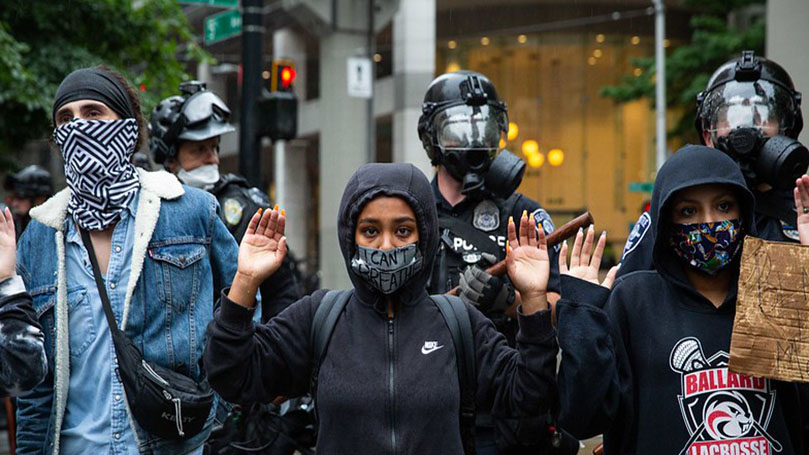
Fascism is “the open terrorist dictatorship of the most reactionary, most chauvinistic, and most imperialist elements of finance capital.” It is a tactic used by capital to develop a political base within the general population, the majority of which never benefits from capitalism’s persistence. According to R. Palme Dutt, the British communist scholar, it is a tool to defend capitalism in deep crisis from socialist alternatives through an attempt at “the violent permanent subjection of the exploited class to the exploiters and crushing all resistance.” It is a stage of capitalist crisis in which big capital, through its political candidates and media campaigns, maintains its power by manipulating violence, nationalism, racism, and sexism.
Germany and Italy before World War II are classic examples. In the period after the collapse of the Soviet Union and the emergence of the U.S. as the single dominant imperialist power, however, signs of fascist re-emergence are ominous. The alliance of U.S. imperialism with parties and movements in the former Soviet Union and Eastern European countries rooted in World War II–era fascism has been well documented. The coziness between the U.S. government and neo-fascist leaderships in Poland, Ukraine, Brazil, India, Philippines, and Hungary reveals a new level of the global danger of fascism.
The capitalist 1% feels compelled to adopt more desperate measures.
Capitalism frequently experiences crises. As a general rule, the system can increase profit margins only at the expense of the living standards of the working class—the very people expected to buy what they make. Crisis is the norm. Failure and collapse is the essence of capitalism. So why isn’t fascism also the political norm for capitalist societies? Like capitalist economic bubbles, capitalist societies cycle through (capitalist) democratic and fascist tendencies. If Dutt is correct, the real possibility of a socialist revolution produces intense desperation for the capitalist 1% to maintain its dominance. It feels compelled to adopt more desperate measures. (Think of Amazon.com’s abuse of its workers under normal conditions. To this, add its motives for offering to use its data harvesting abilities to help the Pentagon in its global operations to suppress resistance to U.S. imperialism. Think of Amazon’s support for police militarization through massive donations to police foundations.)
Neoliberal strategies (capitalist democratic forms of state management of the economy and civil society) have proven a dismal failure in securing capitalist stability. The 2020 COVID-19 pandemic has revealed this failure with more than 120,000 deaths, a rising second wave of infections, and a government paralyzed by its policies of privatization; constitutional forms riddled with vetoes, super majorities, and corporate cash; and technical incompetence imposed by right-wing ideology. The present danger of fascism has been propelled by a collapsing and desperate U.S. imperialist model (a trend pre-dating Trump’s policies) and insurgent socialist movements and processes in Latin America and China, alongside non-capitalist developments and alignments by African countries, and imperialist rivalries in the European Union. The breakdown of U.S. control in the Middle East and Central Asia further exposes the crisis of a unipolar Washington Consensus.
The technologization and mediatization of “smart” war, the growth of internal and external surveillance systems, and systematic elimination of civil liberties in the name of fighting terrorism and crime in the 1990s and early 2000s were not meant simply to extend U.S. imperialist power but also aimed to normalize bigger authoritarian state power. The militarization of police, the demand for deference to abusive police and state power in the name of public safety, and the elimination of social services to fund a racist prison-industrial complex normalized the abuse of state power, the suppression of resistance, and subjection of working-class and (people’s) democratic struggle to the needs, guidelines, and boundaries of capitalist state power. (Recall “free speech zones” during the Iraq war. This is why the Occupy Movement and the movement against racist statues now feel so new and radical.)
The global collapse of finance capital in 2007–2008 produced a new state of emergency for the capitalist class. Researchers have shown the financial links between right-wing capitalists and the Tea Party in 2009–2010, which promoted a vile, racist campaign alongside an anti-worker agenda. This capitalist-originated strategy fostered a white supremacist movement that tied middle-class and working-class people to the interests of finance capital. It did so because it feared the political and economic consequences of the renewal of New Deal–like social democratic policies, especially a public health insurance system and a “card-check” labor union law.
The Tea Party built relationships among big capital (big donors to the Republican Party), white supremacist militia groups, Republican Party organizations, and fundamentalist religious organizations. Through these, capitalists successfully manipulated middle-class strata: small business owners, sections of labor, and rural communities. The primary purpose of this alliance was to maintain white supremacy and strengthen the power of parts of U.S. capital over the state.
The sympathetic relationship between police and fascist militias is a permanent feature of the fascist danger.
After ascending to power through Trump, the Tea Party’s corporate forces placed their financial and political relations on full display when white supremacist militias, under cover of a Republican Party rally, stormed the Michigan State Capitol to protest “stay home” orders during the pandemic. Observers noted the restrained response by the state police to that violent protest, comparing it with the brutal responses of the police against protesters during the May uprising against racist police violence. The sympathetic relationship between police and fascist militias is a permanent feature of the fascist danger.
The ongoing uprising against racist police violence has exposed the associations between white supremacists, the state, and the police. It has revealed how corporate political donors have funded the militarization of the police and how Wall Street profits from police brutality. Why do these relationships exist? As Lenin noted, the state’s fundamental role is to defend the class rule of the capitalist class. The police serve as the violent and coercive arm of that rule. They do not exist to keep us safe, to solve crimes, or to serve the people. All those TV cop shows we love to watch are the utopian expressions of a socialist law enforcement system that ideologically reinforces illusions about real life. In real life, the police beat, kill, or imprison people who threaten capitalist domination of the state.
The existence of the police as an institution isn’t itself fascism. It is the combination of the police role in defending white supremacy, capitalist control of the state, reactionary political movements, and the open violence against democratic and socialist alternatives that expose the danger of fascism. People are awakening to the reality that white supremacy and capitalism are connected and necessary to each other’s existence.
The mass movement to #DefundthePolice for non-police alternatives to public safety is a correct tactic and strategic policy to re-shape the class forces behind state power and its institutions in a democratic manner. It is a critical struggle against fascism, as well. The frustration we feel at current roadblocks to reform met in city councils, state legislatures, and Congress signals a new understanding of how current political forms are designed to block real changes that threaten the 1% control of the state. Capitalist democracy, especially in its constitutionalist forms, is premised on preserving the power of the 1%. At its best, it has reached the limit of its ability (and desire) to create change.
In addition to voting to end Trump, electing people’s candidates to city councils, state legislatures, public school boards, and Congress, radical alternatives and movements are needed now more than ever to make a just and (people’s) democratic society.
Image: Kelly Kline, Creative Commons (BY-NC-ND 2.0).


 Join Now
Join Now